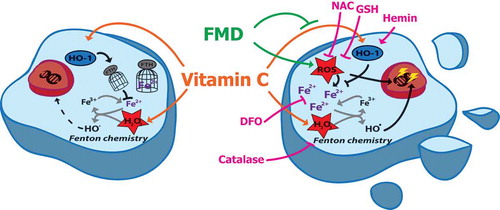Figures & data
Figure 1. FMD sensitizes KRAS-mutant cancer cells to vitamin C. In nutrient-rich condition (left), vitamin C’s toxicity to cancer cells is mostly blocked by the up-regulation of heme-oxygenase-1 (HO-1), which decreases free reactive iron pool (Fe2+) by inducing ferritin (FTH) expression. Fasting-mimicking diet (FMD) reverts the vitamin C mediated HO-1 up-regulation (right), thus increasing the reactive iron pool (Fe2+) and, together with FMD-induced reactive oxygen species (ROS) production, boosts pro-oxidant reactions and Fenton chemistry causing DNA damage (yellow bolts) and cell death. The FMD effect is reversed by treatment with antioxidants such as glutathione (GSH) and N-acetyl cysteine (NAC), HO-1 activator hemin, iron chelator desferrioxamine (DFO) and H2O2 scavenger catalase.

